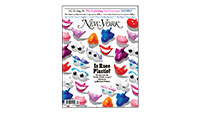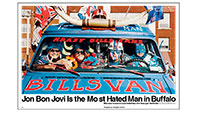 |
1. “The people I interviewed differed in their aesthetics, politics, and medical preferences. But they passionately agreed on one thing: No matter what white people say, this isn’t about them. Plastic surgery doesn’t have to be a sign of deference to some master race … In fact, it could be the opposite,” Maureen O’Connor wrote in her cover story on the rise of the racially charged cosmetic procedures often called “ethnic plastic surgery” (“Is Race Plastic?,” July 28–August 10). “The article is absolutely right—most Asian people (to generalize) want to look like Asian ideals,” wrote one reader at nymag.com. “White isn’t the beauty standard of the world—that’s an outdated, race-ego-centric misperception.” But some others felt the article may have been too credulous about the claims of surgeons and patients that the procedures had little to do with race. One wrote sarcastically: “ ‘Oh, yes, that [surgery] just so happens to entail obliterating all of the distinguishing facial features of my ethnic group and replacing them with those that just happen to resemble white Europeans.’ … Yeah, I could be wrong, but I believe that’s what’s known as denial.” And at Jezebel, Lindy West wondered if there wasn’t a little perspective missing when anyone celebrates plastic surgery as a mark of empowerment. “O’Connor suggests that plastic surgeons who specialize in ‘ethnic’ procedures—mixing and matching ‘ideal’ body parts stereotypically associated with different races—might, in certain ways, be truly post-racial. As though our culture’s current hodgepodge of obsessive beauty ideals—small chin, thin nose, big lips, big eyes, big butt—is the great equalizer,” she wrote. “Personally, my stance on all plastic surgery is the same. Shaming people for things they choose to do to their bodies is never productive. If there are destructive cultural forces—whether patriarchal beauty standards or white supremacy—dictating a cultural phenomenon, then we need to focus on those forces specifically, not the human beings affected by them.”
2. “For someone who seems to be in such plain sight,” Bill Wyman wrote in a meditation on the weirdness of Bob Dylan, “he remains hidden, present but opaque, an open book written in cipher. Normal questions don’t seem to do him justice. You want to ask: What is Bob Dylan? Why is Bob Dylan?” (“Tangled Up,” July 28–August 10). “Dylan’s ‘weirdness’ is a calculated result of his canny and dialectical approach to the expectations of his worshipful fan base,” wrote one reader at nymag.com. “He’s a magpie and showman who understands deeply the craving for authenticity of the middle-class boomers who make up his audience.” Then he added: “He couldn’t quite be said to have single-handedly invented modern hipsterism, because Andy Warhol deserves equal credit.” A few others argued that the singer’s reputation for being a recluse was a bit overblown: “One thing that often puzzles me is the idea that Dylan rarely does interviews,” wrote one reader, linking to a collection of interviews. “It has more than 1,300 pages of Bob interviews and is even indexed. Lots of fascinating stuff. I’ve talked to the guy myself, and I’m nobody.” Others just took the occasion to express thanks that Dylan was still touring. “Treasure the opportunities to still see this artist,” wrote one reader, “because when he goes on, wherever he goes, his myth will rise to eclipse all others of our time.”
 |
3. “Bon Jovi has no great love for the Bills,” Reeves Wiedeman wrote in a story about the “uprising” in Buffalo to prevent the ’80s rocker from buying the cherished football franchise and possibly moving it to Toronto (“Jon Bon Jovi Is the Most Hated Man in Buffalo,” July 28–August 10). When several readers commented dismissively that the world wouldn’t end if the team moved 20 miles north, one Bills fan responded passionately: The Bills “are an excuse for us to forget about the fact that we don’t drive a fancy luxury car and have to pinch pennies to keep the heat on,” he wrote. “They are a blue-collar team ... Hell, if you ever just saw the stadium you would see that over 50 percent of the stadium is hard metal bleacher seating, not soft plastic seats. And to add on top of that, it is an open-air stadium just off Lake Erie, which allows for some bone-chilling winds that pierce even the thickest of coats. But us fans sacrifice our hard-earned money, drive hours through white-out conditions, sit on frozen metal seats, drink overpriced beer, sit in the frozen ice box that is the Ralph, and hope, hope that the Bills don’t lose too badly. The funny thing is we then repeat the same torture the following Sunday like proper masochists.” “The article is chock full of delightful details,” wrote Diana Moskovitz at Deadspin, “but the spotlight belongs to the newly minted Hall of Famer from Buffalo,” retired wide receiver Andre Reed. “He is pissed.” USA Today disagreed: “As heated as Reed’s comments are, they’re far from the most outrageous in the story. No, those belong to a 44-year-old suburban Buffalo hairstylist and hard-core Bon Jovi fan named Jamielynn Richter, who ‘prefers to be called Jovilynn, the name on her business card, or, ideally, just Jovi.’ ”